Four decommissioned telescope projects are assisting scientists in gaining fresh insights into the behavior of dust in galaxies.
According to astronomers, a new study of gas and dust encircling four galaxies, all of which are close to our own Milky Way, will give new knowledge on star formation.
“These better photos demonstrate that the dust ‘ecosystems’ in these galaxies are quite dynamic,” said Christopher Clark, imaging team head and astronomer at the Space Science Telescope Institute in Baltimore, in a release Thursday (June 16).
The observations were guided by data from the European Space Agency’s (ESA) Herschel Space Observatory, which operated from 2009 to 2013 and discovered dust’s thermal signature in far-infrared light.
The researchers also used data from the European Space Agency’s Planck project, which ended in 2013, as well as NASA’s Infrared Astronomical Satellite and Cosmic Background Explorer missions, which ran in the 1980s and 1990s.

Although all space telescopes ultimately die due to component failure or a shortage of fuel, their data may last indefinitely as long as it is properly archived.
Astronomers return to old data on a frequent basis to quantify long-term changes in galaxies, black holes, exoplanets, and other astronomical objects of interest, as well as to apply new research methods.
The newly created pictures concentrate on interstellar dust and gas in order to understand more about how the density of dust clouds varies across galaxies as well as within a single galaxy.
Dust originates when dead stars release layers of gas, and its route is influenced by pressure waves from exploding stars, active stellar winds, and gravitational forces from other objects.

All of that dust has a significant impact on astronomers’ work because it absorbs light from the objects being studied – roughly half of the universe’s illumination, according to the statement.
However, dust is not always a problem. Dust may help scientists comprehend the development of the universe since it includes a variety of heavier elements, such as those found in planets.

Herschel data was especially useful, revealing insights on how dust is organized inside interstellar clouds, while other observatories filled in the gaps.
The study comes despite the fact that the Herschel telescope, according to the statement, was not meant to look at light from diffuse clouds or in the outer parts of galaxies where there is less gas and dust.
Using data from the quartet of observatories, scientists calculated that the dust-to-gas ratio in a single galaxy may vary by a factor of 20, considerably above previous predictions.
The interaction of components between galaxies is highly complicated, indicating the way for future research to focus on specific processes.
“In the densest dust clouds,” the statement said, “nearly all of the heavy elements may get trapped in dust grains, increasing the dust-to-gas ratio.”
In less dense places, however, the destructive radiation from newborn stars or shockwaves from exploding stars would break the dust grains and release some of the locked-up heavy elements into the gas, altering the ratio once again.”
The findings were announced during a press conference at the American Astronomical Society’s summer meeting, which took place from June 12 to June 16.













